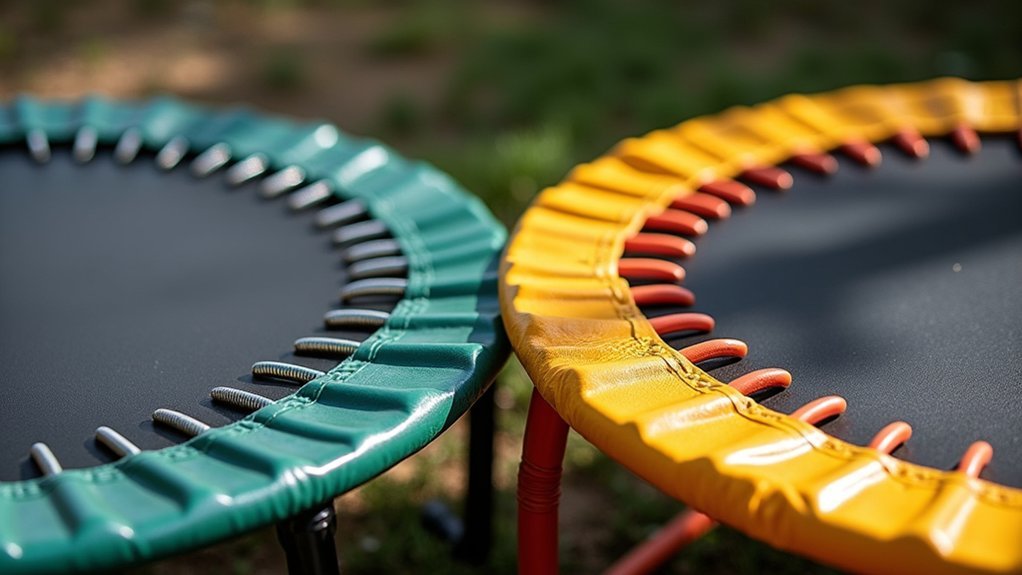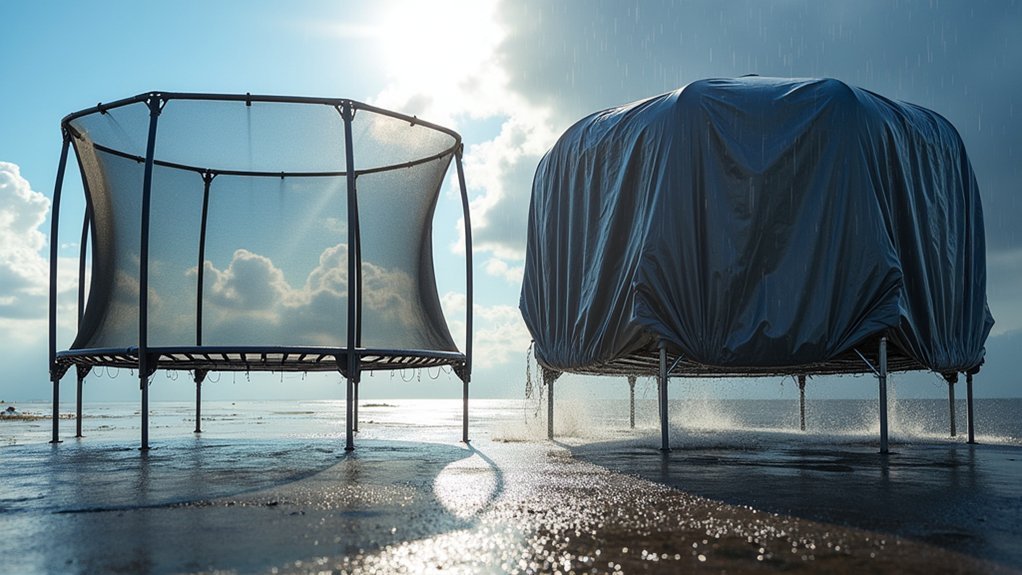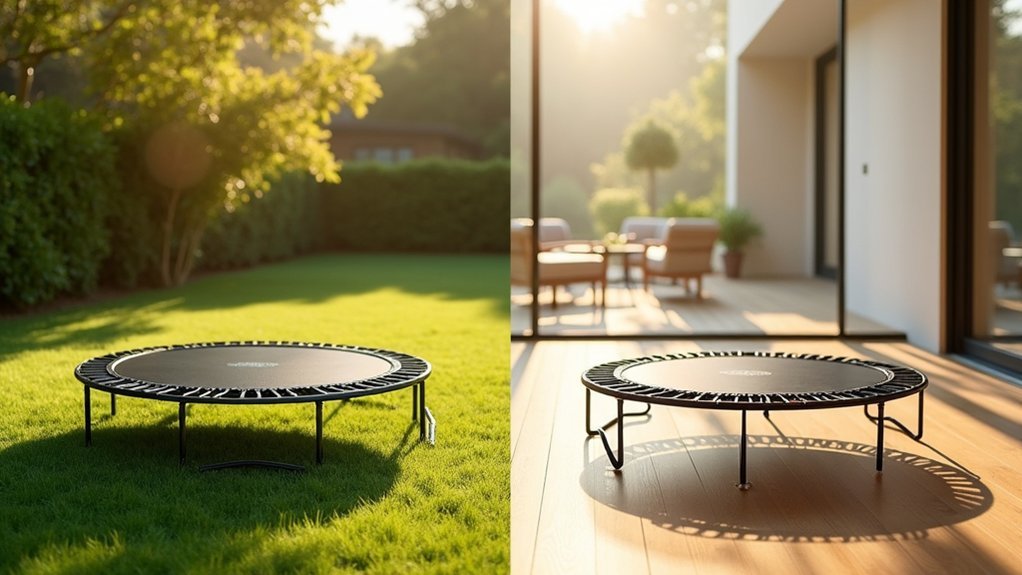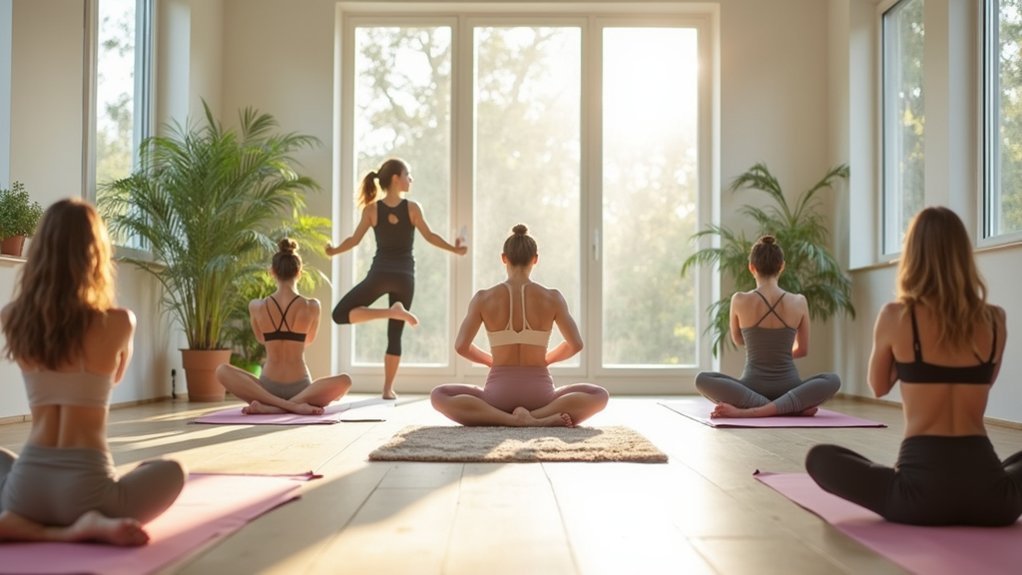Indoor and outdoor rebounders differ primarily in size, construction, and purpose. You’ll find indoor models are compact (35″-48″ diameter), portable, and designed for gentle, controlled bounces with bungee cords for joint protection. Outdoor versions are larger (100″+ diameter), weather-resistant with galvanized steel frames, and built for higher jumps and multiple users. Indoor units prioritize storage convenience and quieter workouts, while outdoor models emphasize durability against elements. These key distinctions will help guide your perfect rebounding investment.
Size Differences: Compact vs. Expansive Designs

Dimensions play an essential role in distinguishing indoor rebounders from outdoor trampolines. While indoor models typically range from 35″ to 48″ in diameter, outdoor trampolines easily exceed 100″ to accommodate recreational jumping.
If you’re tight on space, indoor rebounders are designed with home use in mind—most fold for closet storage and require just a 5’x5′ area for safe exercise. Their compact 40″-44″ size works well for fitness routines while maintaining stability with lower 12″ frames. Most high-quality rebounders feature steel frames for safety and durability during regular use.
Your height matters too. If you’re taller, look for rebounders at least 44″ in diameter to guarantee proper legroom during lateral movements. Smaller 36″ models might restrict your full range of motion, especially during upper-body exercises or dynamic HIIT workouts.
Portability Factors: Relocation and Storage Considerations
When considering a rebounder purchase, portability features can make or break your long-term satisfaction with the equipment. Higher-end models offer foldable frames and included carry bags, with lighter options weighing under 20 pounds for easier transport.
Indoor rebounders typically feature quick-lock systems for tool-free assembly in under 5 minutes, while outdoor variants may sacrifice some portability for weather resistance and stability. The SereneLife 40 Portable Foldable stands out as an extremely silent bounce option that’s fitness class approved.
When folded, most compact models reduce to just 4-6 inches thick, perfect for under-bed or closet storage.
Storage considerations should include your climate conditions—outdoor units require protection from moisture.
The portability-durability trade-off is real: thicker, more durable mats add weight but last longer.
Consider the compromise: durable mats offer extended lifespan but sacrifice some portability with their additional weight.
Be aware that highly portable models might come with shorter warranty periods compared to their stationary counterparts.
Bounce Mechanisms: Spring Types and Tension Variations

Indoor and outdoor rebounders feature either traditional metal springs or bungee cord systems, with bungees typically offering gentler impact absorption for your joints.
You’ll notice outdoor models incorporate weather-resistant materials in their bounce mechanics, protecting against rust and UV damage that would otherwise compromise performance.
The tension variations available in premium models let you customize your workout intensity, with higher resistance settings challenging your muscles more effectively during exercise routines. Unlike traditional trampolines that provide higher jumps for recreational use, rebounders maintain controlled, low-impact motion specifically engineered for fitness purposes.
Spring vs. Bungee Systems
The debate between spring and bungee rebounders centers on fundamentally different bounce mechanics that create distinct workout experiences.
Spring systems deliver immediate, vertical energy transfer with rapid bounce cycles of 100-120 per minute, while bungee cords provide a slower, diagonal rebound that absorbs more impact.
You’ll find spring rebounders excel at high-intensity workouts, plyometrics, and cardio training where quick responsiveness matters. They maintain tension longer, typically lasting 5-10+ years before needing replacement. Many users choose metal sprung rebounders specifically for their ability to support faster tempo workouts at 130 bpm or higher.
Bungee systems, though quieter and gentler, require more frequent maintenance as cords stretch and degrade within 1-3 years.
Your intended use matters too—springs suit performance-focused exercise, while bungees offer a softer experience ideal for rehabilitation and low-impact training.
Consider your workout style when choosing.
Impact Absorption Differences
Beyond the fundamental choice between spring and bungee systems, understanding how different rebounders absorb impact reveals why your workout experience can vary dramatically between models.
Indoor rebounders typically feature softer, more controlled bounce mechanisms designed for joint protection during fitness routines. You’ll notice they limit bounce height to minimize stress on your body. These models are ideal for low-impact exercise that activates the lymphatic system through gentle, controlled movements.
Outdoor models, however, incorporate stronger tension systems capable of supporting multiple users and higher jumps. These differences aren’t just about bounce quality—they affect long-term joint health.
Indoor rebounders prioritize consistent, low-impact absorption for repetitive exercise, while outdoor versions balance recreational fun with safety considerations.
When selecting your rebounder, consider how the tension mechanism matches your workout intensity and fitness goals. The right impact absorption system will provide the perfect balance between effective exercise and bodily protection.
Weather-Resistant Bounce Mechanics
Weather-resistant bounce mechanics represent an essential point of differentiation between indoor and outdoor rebounders, particularly when examining spring types and tension variations.
Outdoor rebounders require special considerations to maintain performance in changing environments. While metal springs offer consistent bounce, they’re vulnerable to corrosion without protective coatings. Injury risk increases with deteriorated springs that may break unexpectedly during use.
Bungee cord systems, with their softer landings, often demonstrate better weather resistance for outdoor use.
When you’re choosing a rebounder for outdoor workouts, look for models with coated springs or weather-resistant materials. These design elements prevent degradation from moisture and temperature fluctuations while maintaining consistent tension.
Indoor rebounders, conversely, don’t require the same weather protection but still benefit from adjustable tension settings that allow you to customize resistance levels based on your fitness goals and exercise variety.
Weather Resistance: Materials That Stand Up to the Elements

When choosing an outdoor rebounder, you’ll need materials that can withstand nature’s harshest conditions. Look for frames made of galvanized or powder-coated steel, which resist rust and corrosion from rain and snow.
Polypropylene jumping mats with UV protection will maintain their elasticity longer under direct sunlight.
Don’t overlook accessories that enhance weather resistance. Quality covers with drainage systems prevent water pooling, while spring covers protect vital components from moisture.
For complete protection, consider frame covers and reinforced netting that can handle high winds. Regular inspection of your rebounder is crucial as severe weather events continue to increase in frequency.
Regular maintenance is essential: inspect for rust, clean debris, and store removable parts indoors during extreme weather.
These practices, combined with weather-resistant materials, will guarantee your outdoor rebounder delivers consistent performance year-round while saving you money on replacements and repairs.
Exercise Applications: Targeted Workouts for Each Type
The two distinct rebounder categories offer uniquely tailored fitness experiences based on their structural design.
Indoor rebounders excel at low-impact, controlled workouts focusing on core stabilization and steady-state cardio. You’ll benefit from their tension-based systems during rehabilitation or when targeting smaller stabilizing muscles. Many indoor models use bungee cords instead of springs to provide superior joint protection during exercise routines.
Outdoor trampolines accommodate explosive movements like tuck jumps and flips, engaging leg muscles more aggressively. Their larger surface area (8-16ft+) supports sport-specific drills, group games, and obstacle course-style challenges.
Your fitness goals should dictate your choice: indoor models deliver efficient calorie burning and lymphatic drainage through rhythmic, repetitive motions in limited space.
Meanwhile, outdoor versions enhance vertical jump height and reactive agility through higher bounces, making them ideal for plyometric training and social fitness activities.
Weight Capacity and Structural Integrity
Structural integrity forms the foundation of every rebounder’s performance, with weight capacity serving as a critical distinguishing factor between indoor and outdoor models.
You’ll notice outdoor versions typically support higher weights (up to 550 lbs) compared to indoor models (300-450 lbs), reflecting their different design priorities.
- Frame Construction – Outdoor rebounders feature reinforced steel frames with galvanized coatings for rust resistance, while indoor units prioritize lightweight alloys for portability.
- Support Systems – Outdoor models use crossbar reinforcements for even weight distribution; indoor versions often employ quieter bungee cords instead of springs. Indoor models like the DARCHEN Rebounder Mini Trampoline deliver a softer, quieter bounce compared to spring-based alternatives.
- Leg Design – Wide-based outdoor legs may include ground anchors; indoor legs feature anti-skid rubber to protect flooring.
- Material Quality – Weatherproof polymers for outdoor mats contrast with the textured PVC surfaces common in indoor models.
Safety Features: Stability and Fall Prevention
Safety features represent the next frontier beyond mere structural integrity, with both indoor and outdoor rebounders incorporating specific elements to maximize stability and prevent falls.
Indoor models typically feature foldable legs and non-slip mats, while outdoor versions boast heavier frames and textured surfaces for grip on various terrains.
The wise fitness enthusiast selects indoor rebounders for portability and slip resistance, outdoor models for durability and all-terrain performance.
Many rebounders include adjustable safety bars or handles that provide essential balance support during workouts. Some models offer various color choices to help you identify the correct grip positions at a glance. Look for models with height-adjustable handlebars to accommodate different users and exercises.
Outdoor rebounders often include ground anchoring systems to prevent tipping, while indoor versions may have leveling mechanisms to compensate for uneven flooring.
For maximum safety, make sure you’ve got ample space around your rebounder and keep your weight centered during exercises.
Remember that larger rebounders generally offer more stability due to their wider base area.
Maintenance Requirements and Longevity
Maintaining your rebounder properly determines not just its lifespan but also your safety during workouts. Indoor units generally outlast their outdoor counterparts due to less environmental stress, with UV-resistant mats lasting 3-5 years outdoors versus 5-8 years indoors.
For peak performance and longevity:
- Clean indoor rebounders monthly with mild soapy water and microfiber cloths, while outdoor models need weekly inspections for debris and fraying.
- Never pressure wash any rebounder as this damages seams and weakens structural integrity.
- Replace springs every 1-2 years for outdoor units versus 3-4 years for indoor models.
- Store outdoor rebounders with breathable covers or disassemble completely during harsh winters, while keeping indoor models elevated from damp floors.
- Conduct systematic checks of all components to prevent unexpected equipment failure and ensure user safety.
Cost Analysis: Investment Value for Different Needs
Investing in a rebounder represents more than just an upfront purchase—it’s a calculated decision that balances initial cost against long-term value.
Entry-level models ($25-$100) suit occasional users, while serious rebounders benefit from mid-tier options ($100-$200) with enhanced stability.
Outdoor models typically cost $50-$300, with weatherproofing features adding 15-20% to the base price.
Indoor-specific features like noise reduction and floor protection add $20-$50 but protect your home environment.
The true value emerges in cost-per-use analysis: $200+ models become economical at less than $0.50 per session after 400 uses.
Family or commercial settings benefit from premium models ($200-$1000+) that offer better ROI through durability and higher weight capacities, ultimately supporting multiple users with warranties justifying the investment.
Models with bungee suspension tend to be quieter and gentler on joints compared to spring-based options, though they often command a higher price point.
Environmental Adaptations: Climate and Exposure Factors
Designed to withstand diverse environmental challenges, outdoor rebounders require strategic material selection and construction techniques that indoor models simply don’t need. Your outdoor trampoline faces constant battles with nature’s elements that can quickly degrade inferior materials.
- Temperature extremes affect frame integrity and mat elasticity – quality outdoor models use materials that won’t crack in cold or warp in heat.
- UV exposure degrades standard plastics and fabrics – look for specifically UV-treated components that resist sun damage. Outdoor trampolines are specifically constructed with UV-resistant jumping mats to ensure longevity despite constant exposure to sunlight.
- Moisture resistance is vital – proper drainage systems and rust-resistant metals prevent water accumulation and corrosion.
- Wind vulnerability requires consideration – heavier frames and secure anchoring systems keep your rebounder safely in place during gusts.
Frequently Asked Questions
Can Rebounders Help With Lymphatic Drainage and Detoxification?
Yes, rebounders can help with lymphatic drainage and detoxification. When you bounce, you’re stimulating your lymphatic system, improving circulation, and enhancing waste removal. They’re particularly effective because they’re low-impact yet stimulate cellular movement throughout your body.
Are Rebounders Suitable for People With Back Surgery or Injuries?
If you’ve had back surgery or injuries, rebounders can be suitable with proper precautions. Choose bungee models with stabilizing handles and start with gentle movements. Always consult your healthcare provider before beginning.
How Loud Are Rebounders Compared to Treadmills and Ellipticals?
Rebounders are considerably quieter than treadmills and ellipticals. You’ll notice they generate 50-65 dB compared to treadmills’ 60-80+ dB, as they lack motors and create less impact noise during your workout.
Can Children and Adults Safely Share the Same Rebounder?
No, you shouldn’t let children and adults share a rebounder simultaneously. The limited surface area, weight differentials, and varying bounce needs create instability risks. Sequential use with proper supervision is safer for different users.
Do Rebounders Require Special Footwear or Can You Bounce Barefoot?
You can safely bounce barefoot on rebounders, which enhances foot strength and proprioception. However, you’ll want socks for hygiene on shared equipment or shoes for outdoor models to protect against debris.
In Summary
When choosing between indoor and outdoor rebounders, you’ll need to assess your space, weather conditions, and workout goals. Indoor models offer convenience and space efficiency, while outdoor versions provide durability against elements and often more bounce variety. Whichever you select, you’re investing in a low-impact exercise option that’s adaptable to your specific needs and environmental constraints.





Leave a Reply